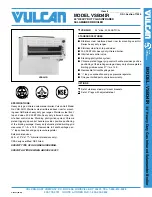
Mighty Therm Lo-Nox
Page 19
3.
If a strainer is used in a pressure reducing valve
or in the piping, clean it every 6 months in
accordance with the manufacturer's instructions.
4.
At startup and every 6 months after, using the
burners view port, look at the burner flame for
proper performance. The burner should not
require maintenance in normal operation. If any
malfunction indicates that the burner needs
service (e.g., a flame that is yellow, or entire
burner surface glowing red), call a professional
service technician. The flame should be checked
for the following:
a.
Normal Flame: Blue flame color, with
slight yellow tips, with a well-defined inner
cone.
b.
Yellow Flames: Can be caused by blockage
of primary air flow to the burner(s) or
excessive gas input. This condition MUST
be corrected immediately.
c.
Lifting Flames: Lifting flames can be
caused by over firing the burner(s) or
excessive primary air.
5.
Inspect the venting system for blockage, leakage,
and corrosion at least once a year.
6.
Keep the heater area clear of combustible
material, gasoline, and other flammable liquids
and vapors.
7.
Be sure all combustion air and ventilation
openings are not blocked.
5.2 Combustion Air Blower
This heater uses a fan assisted combustion
process. For proper operation of the burners, inspect
the air blower for contamination one week after start-
up and every three (3) months thereafter. Blower
housing inlet must be completely isolated and
protected from any source of corrosive chemical
fumes, and from exhaust vents of cleaning equipment
or laundry establishments.
1.
To inspect and service the blower, shut off all
electrical and gas supply to the heater.
2.
Remove the screws holding the blower housing
cover to expose the blower (see Figure 20).
3.
Remove the air orifice off the blower inlet to
inspect the blower wheel. Clean the blower
housing and its wheel from any contamination or
debris.
4.
Remove manifold compartment cover, inspect
the compartment and around the gas manifold for
lint or any other form of debris. If required,
vacuum out all contamination.
5.
Replace all parts securely in place.
Figure 20. Blower-Housing.
5.3 Heat Exchanger
Check for fouling on the external surfaces of the
heat exchanger every six months. (NOTE: After
installation and first start-up, check the heat exchanger
for fouling after the following periods of operation: 24
hours, 7 days, 30 days, 90 days, and once every six
months thereafter).
WARNING
Improper installation or maintenance can cause
nausea or asphyxiation from carbon monoxide
in flue gases which could result in severe
injury, property damage, or death.
Fouling on the external surfaces of the heat
exchanger is caused by incomplete combustion and is
a sign of combustion air and/or venting problems. As
soon as any fouling is observed, the cause of the
fouling should be corrected. The heat exchanger can
be checked by removing the venting and top panel as
necessary to inspect from above. Also check the vent
system for defects at this time.
5.3.1 External Cleaning of Heat
Exchanger
1.
If cleaning is required, disconnect electrical
supply to the heater and remove wires and
conduit from the heater’s pump.
2.
Turn off the gas supply by closing the manual
gas valve on the heater.
3.
Isolate the heat exchanger from water supply.
4.
Remove the vent pipe (for outdoor units remove
vent top assembly), top panel, upper jacket
assembly and flue collector (see Figures 22 and
28).
5.
Drain the heat exchanger.
















































